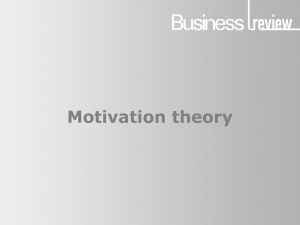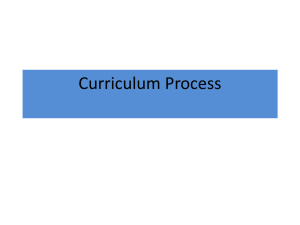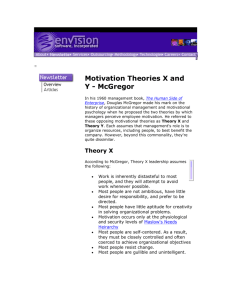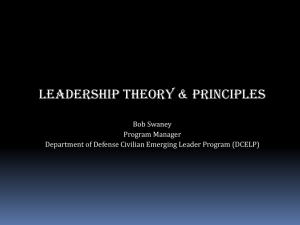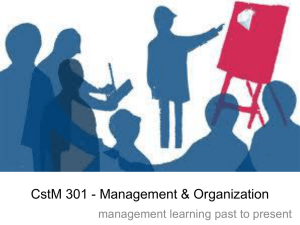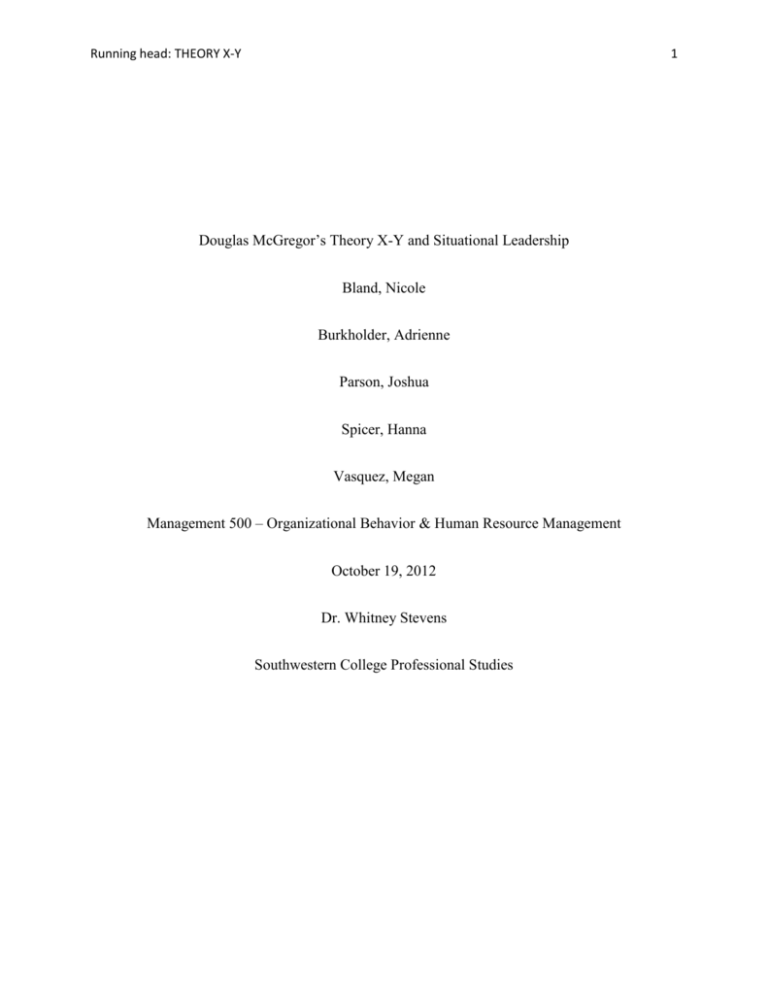
Running head: THEORY X-Y
1
Douglas McGregor’s Theory X-Y and Situational Leadership
Bland, Nicole
Burkholder, Adrienne
Parson, Joshua
Spicer, Hanna
Vasquez, Megan
Management 500 – Organizational Behavior & Human Resource Management
October 19, 2012
Dr. Whitney Stevens
Southwestern College Professional Studies
THEORY X-Y
2
Table of Contents
Content
Page
1. Abstract…………………………………………………………………………
2. Thesis…………………………………………………………………………...
3. X-Y Theory in Relation to Situational Leadership…………………………….
4. X-Y and Maslow’s Hierarchy as it relates to Situational Leadership……….....
5. Theory X and Situational Leadership in Manufacturing Environments.............
6. Theory Y and Situational Leadership in Manufacturing Environments.............
7. X-Y and Situational leadership in Non-Manufacturing Environments..............
8. Conclusion..........................................................................................................
9. References..........................................................................................................
THEORY X-Y
3
Abstract
THEORY X-Y
4
Douglas McGregor’s Theory X-Y and Situational Leadership
X-Y Theory in Relation to Situational Leadership
Devised by Douglas McGregor in his 1960 book “The Human Side of Enterprise”,
Theory X and Theory Y first originated in an effort to understand the motivation behind what
drives employees. The theories are based on how human motivation is created and developed
and were study by Dr. McGregor while at the MIT Sloan School of Management (McGregor,
2006). Theory X and Y are based on the perceptions managers hold regarding the origin for
motivation for employees, and originated in the 1960’s. There have been a variety of changes in
management styles, industry standards, and employee expectations since the 1960’s that must be
taken into consideration. The theories both postulate motivational origin for an employee,
however, each discover differing motivational means for employees or followers. The merging
of the theories is rather a continuum as they are not different ends of the same continuum.
In understanding that Situational Leadership is based on four leadership behaviors that
were derived from a 2006 study of Dr. Paul Hersey at The Center for Leadership Studies, it can
become evident how the leadership behaviors are derived from what it is that motivates the
leaders. Leaders are motivated by a variety of factors, which are the motivational concepts
discussed in Theories X and Y. Occurring nearly fifty years after the origination of McGregor’s
Theory X-Y, the Situational Leadership Theory is based on the four leadership behaviors which
are composed of different factors, including a variety of motivating factors as studied and
theorized in McGregor’s Theory X-Y.
In the Situational Leadership Theory the behavioral types were determined based on the
levels of situational behavior and directive behavior which were then charted to determine
THEORY X-Y
5
quadrants of the four behavior types; also taking into consideration the readiness level of the
follower. Within the Situational Leadership Theory as presented by Dr. Hersey, the four
behavior types are as follows: Telling (S1), Selling (S2), Participating (S3), and Delegating (S4)
(Hersey, 2012). Telling Leaders tell their people exactly what to do, and how to do it. Selling
Leaders still provide information and direction, but there’s more communication with followers.
Leaders “sell” their message to get the team on board. Participating Leaders focus more on the
relationship and less on direction. The leader works with the team, and shares decision-making
responsibilities. Delegating Leaders pass most of the responsibility onto the follower or group.
The leaders still monitor progress, but they are less involved in decisions (The Center for
Leadership Studies, 2012).
In the perspective of utilizing Theory X-Y in aspects of how it relates to Situational
Leadership Theory, the consideration of the followers readiness levels and motivational sources
are relevant. For the Situational Leadership Theory, the readiness levels of the followers are
attributed to what leadership style is needed. Theory X-Y looks to the factors of motivation for
determining how to best determine the most effective leadership style for motivating and leading
the followers would be. Depending on the followers’ readiness (as pertaining to the Situational
Leadership Theory) or the factors by which the follower is motivated (as pertaining to Theory XY), the leadership style is best determined.
Leadership theories, such as McGregor’s Theory X-Y, are the foundations for the Theory
of Situational Leadership as they have grown and changed over the years. Situational
Leadership Theory takes the basis of what motivates the followers (as first discussed in Theory
X-Y) and expounds on how to most effectively manage the followers. By understanding what
motivates followers, determining the follower readiness, and identifying behavioral types (as
THEORY X-Y
6
discussed in the Situational Leadership Theory), leaders are best able to provide effective
situational leadership. For both theories, the focus is on the behavior and motivation of the
follower or employee, which exemplifies the importance of the follower in leadership theory.
Theory X and Situational Leadership in Manufacturing Environments
The premise that manufacturing has changed over the times since the industrial
revolution is a solid foundation to pillar up the thought that it will continue to change. While
technology has had an impact, the management and leadership of manufacturing have also
molded itself in an attempt to find the peak performance of employees on the shop floor.
McGregor’s Theory X states, “Without this active intervention by management, people would be
passive—even resistant—to organizational needs. They must therefore be persuaded, rewarded,
punished, controlled—their activities must be directed” (McGregor, Cutcher-Gershenfeld, 2006).
With McGregor’s theory in mind, every employee’s motivation can be managed through a
punishment and reward system based solely on monetary gain. Theory X particularly pulls from
the findings of Elton Mayo, who found that employees that worked in a culture such as this left
themselves to a feeling of helplessness and frustration with their particular jobs no matter what
the income level.
The manufacturing world was forever changed by McGregor’s findings, but after a
century of exploration into different leadership styles, the results still remain the same.
Situational Leadership allows a leader to use whatever style fits best by understanding the
variables of the leader, the followers, and the situation that has presented itself. When using a
Theory X model in manufacturing, a leader will notice the moral and production of the shop to
become stagnant. McGregor’s theory shows us why a dormant situation resulted. He noted that
“Consider your own need for air. Except as you are deprived of it, it has no appreciable
THEORY X-Y
7
motivating effect upon your behavior” (McGregor, Cutcher-Gershenfeld, 2006). The followers,
as far as the Situational Leadership model is concerned, have become the part of the equation
that has no chance at changing to the adapting needs of the company.
The Theory Y and Situational Leadership in Manufacturing
Theory Y is the democratic approach to leadership. This opposite end of the spectrum
has a belief in the employee to become self-motivated, to feel like work is as natural as play, and
to hold within them the capacity in solving organizational problems (Hersey, 2008). Based upon
the light experiments in the 1920’s at Western Electric Company by Mayo, McGregor knew that
the production value of an employee was directly parallel with the feelings of worth and
acceptance provided by the employer. Self esteem adds a dimension into the variable in the
formula for Situational Leadership. If the followers can be changed to adapt towards the needs
of the other two variables, then a middle ground meeting of all three variables can lead to a
higher possible production value.
The quest for excellence in performance can be aptly summarized by the findings of
human engineer, Cavett Robert. He is quoted as saying that 15% of the reason you get a job,
keep that job, and move ahead in the job is determined by your technical skill and technical
knowledge. He continues that 85% of the reason you get a job, keep that job, and move ahead in
the job has to do with your people skills and people knowledge (Abdullah, 1999).
Manufacturing performance results in being based not only on what the follower variable can do,
but the rewards received by being a good Situational Leader. Being able to read and interpret the
signs of the followers as individuals and as a group can grow a deep feeling of worth and respect
for the leader. A Situational Leader who uses such scenarios for the benefit of the company will
not only receive the satisfaction of a job well done, but also a personal feeling of contentment.
THEORY X-Y
8
Theory Y is not completely applicable in all situations due to its need for the company to breed a
workplace that accepts Theory Y employees as the preferred choice. However the closer a
Situational Leader can adapt their environment to a Theory Y style group, the better the
manufacturing production value will be.
X-Y and Situational leadership in Non-Manufacturing Environments
McGregor’s Theory X-Y of the ways managers motivate employees is dependent on
beliefs and assumptions about human nature. When separating the two and defining them,
McGregor predicted managers that were Theory X assumed employees needed to be controlled,
directed, or threatened with punishment to gain effort toward organizational objectives.
Managers assumed employees avoid taking responsibility; lacking self-direction and having
unfavorable opinions about work and the organizational objectives (Hersey, 2008).
McGregor predicted managers that were Theory Y assumed their employees have selfcontrol and self-direction. Managers assumed such employees have instinctual motivation to
preform, resulting in accomplishing meaningful work and would hold themselves accountable to
making sure they achieve results to enhance the organization effectiveness (Hersey, 2008)
The assumptions of McGregor theories have given false impressions. To some, the
Theory X managers are all the worst kind of managers while Theory Y managers are the greatest
kind of managers. However, some believe Theory Y is the same as Theory X just with the
allowances of human emotions. All managers are ultimately responsible for the end results; they
are in charge of the planning process and getting employees motivated and on board with
achieving the organizations goals.
Situational Leadership differentiates its approach from theories by emphasizing managers
to change the management style and adapting based on the situation of the group or organization.
THEORY X-Y
9
Leaders performing situational approaches may need to change a style continually to meet the
needs of others or the organization based on the particular situation at hand. Situational
Leadership is based on relationships between an individual’s development level on specific task
and goals as well as the leadership style a leader provides. Below are illustrated models with the
four leadership styles and four development levels of the follower.
Figure 1.1
Figure 1.1 shows the four leadership styles S1 to S4:
S-1: Directing- leaders define the roles and task of the “follower” and supervises them
closely. Decisions are made by the leader and announced, communication is largely one-way.
S-2: Coaching-leaders still define roles and task, but seek ideas and suggestions from the
follower. The decisions still are made by the leader, communication is more two-way.
S-3: Supporting-leaders pass day-to-day decisions; task allocation and process are given to
the follower. The leader gives control to the follower, but still takes part in the decision part.
THEORY X-Y
10
S-4: Delegating-leaders are involved in the decisions and problem-solving, but the follower
has control telling the leader when and how to be involved.
When choosing the right leadership style, the leader must evaluate the development of the
follower to successfully choose the right style. Figure 1.2 lists the four development levels.
Figure 1.2
D-1: Low Competence, high commitment- general lack of specific skills are required but
follower is eager to learn and willing to take direction.
D-2: Some competence, low commitment- some relevant skills, but need help doing the job
task may be new to them.
D-3: High competence, variable commitment-experienced and capable, however lacks
confidence to do the task alone and motivation to do it well.
D-4: High competence, high commitment- experienced and comfortable at the job may even
be more skilled as the leader.
McGregor’s Theory X-Y and Situational Leadership approached do have comparisons.
Some leaders, depending upon the situation, need to adjust leadership style to a directive
behavior spelling out the employees roles and telling the employee what to do, when to do, and
where to do it. Directive leadership style articulates a Theory X manager approach giving
structure, control, and supervision. Supportive behavior resembles Theory Y: the manager
engages in open communication with the employee, provides support and encouragement, and
THEORY X-Y
11
facilitates interaction involving the employee in the decision making process. While both X and
Y methods are different, they are alike when using same styles of leadership. A difference is
shown when the manager is a Theory X user, Theory Y user, or if the manager can adapt to
either style depending on the situation and or the employee.
X-Y and Maslow’s Hierarchy as it relates to Situational Leadership
Douglas McGregor’s motivational theory also drew heavily from the works of Theorists
Abraham Maslow and Elton Mayo. Abraham Maslow’s pyramid diagram known as “The
Hierarchy of Needs” represents individual characteristics of the subjects in McGregor’s X-Y
theory. As Figure 1.3 depicts, those employees at the bottom of the pyramid are motivated by
basic needs such as food, water, shelter, and sleep while those at the top of the pyramid strive to
achieve creativity, problem solving, and self-satisfaction. Maslow’s theory explains that an
employee can be found throughout a hierarchy; however, lower levels of the pyramid must be
satisfied prior to having motivation to move higher (Learning Theories Knowledgebase, 2012).
Figure 1.3
Elton Mayo’s Hawthorne Studies observed the degree of employee production while put
under variable environmental situations. Mayo concluded that employee motivation was driven
THEORY X-Y
12
more by relationships built within the organization than that of monetary values. Mayo also
theorized that attitudes of American laborers were driven by work conditions, social relations,
and undoubtedly the need to collaborate and communicate with peers (Reshef, 2000). The
Hawthorne studies found that the majority of American workforce saw employment as
degradation to simple tasks of labor in exchange for a wage. In response, Mayo’s “Rabble
Hypothesis” implies that a managerial assumption of disgruntled employees who are
unmotivated and only concerned with self-preservation. In conjunction with Abraham Maslow’s
Hierarchy of needs, Elton Mayo assumed that individuals are only motivated by basic needs and
have little interest in their work (Hersey, 2008).
Douglas McGregor uses the work of both Elton Mayo’s Rabble Hypothesis and Abraham
Maslow’s Hierarchy of Needs to theorize employee motivation levels known as Theory X-Y.
McGregor suggests employees of “Theory X” are motivated by the basic needs at the bottom of
Maslow’s pyramid. McGregor concludes that managers assume subjects of Theory X generally
dislike work, have little ambition, innovation, and constantly seek direction. Thus, managing the
individuals of Theory X takes excessive structure and oversight (Hersey, 2008). A dictatorial
type of management does not yield positive results nor does it aid in the development of
employee satisfaction. In addition, this leadership style rarely relates to followers and bears few
altruistic qualities (Chapman, 2010). Two years ago McGregor wrote: “Management by
direction and control may not succeed because it is a questionable method for motivating peoples
whose physiological and safety needs are reasonably satisfied and who’s social, esteem, and selfactualization needs are becoming predominant” (McGregor, 2010, p.1). On the contrary,
McGregor theorized that individuals who are found higher in the Maslow’s pyramid are of
“Theory Y.” The subjects of Theory Y are self-starters and motivated by creativity. McGregor
THEORY X-Y
13
postulates that managers of Theory-Y subjects assume employees find pleasure in work where
they can creatively solve problems, be self-directed, and motivated by self-esteem. Managing
employees of the Theory-Y sector takes little oversight and direction.
The traditional American organization has changed drastically since Douglas McGregor’s
1960 Theory X-Y was postulated. Access to education, technology, and standards has changed
the face of the workforce demographic. The Center of Leadership, Paul Hersey, and Kenneth
Blanchard recognized the need for situational leadership research to identify the underlying
variables of organizations and employee motivation (Hersey, 2008). The incorporation of
situational leadership into the Rabble Hypothesis, The Hierarchy of Needs, and McGregor’s
Theory X-Y would have great effects on employee behavior and motivation.
Conclusion
THEORY X-Y
14
References
Abdullah, M. (1999). The Quest for Peak Performance. New Straight Times, 2. Retrieved from
http://www.lexisnexis.com.ezproxy.sckans.edu/hottopics/lnacademic/?
Blanchard, K. (1991). Situational View of Leadership. Executive Excellence, 8(6). Retrieved
from
http://ezproxy.sckans.edu/login?url=http://search.proquest.com/docview/204623248?acco
untid=13979;
Center for Leadership Studies. (2012, June 20). The Driving Force Behind the Situational
Leadership Model. Retrieved from http://www.situational.com/about-us/situationalleadership/
Chapman, A. (2010). Douglas McGregor – Theory X Y. Retrieved from
http://www.businessballs.com/mcgregor.htm
Hersey, P., Blanchard, K., and Johnson, D. (2008). Management of Organizational Behavior:
Leading Human Resources. (9th ed.) Upper Saddle River, NJ: Pearson Prentice Hall.
Learning Theories Knowledgebase. (2012). Maslow’s Hierarchy of Needs. Retrieved from
http://www.learning-theories.com/maslows-hierarchy-of-needs.html
McGregor, D., Cutcher-Gershenfeld, J. (2006). The Human Side of Enterprise: Annotated
Edition. New York, NY: McGraw-Hill.
McGregor, D. (2010). Theory X and Theory Y: Situational Leadership. Retrieved from
http://www.qiyadame.com/section-list/6-general-blogs/140-theory-x-theory-y
Reshef, Y. (2000). Elton Mayo and The Human Relations Movement 1880-1949. Retrieved from
http://apps.business.ualberta.ca/yreshef/orga417/mayo.htm
Russ, T. L. (2011). Theory X/Y Assumptions as Predictors of Managers' Propensity for
THEORY X-Y
15
Participative Decision Making. Management Decision, 49(5), 823-836. doi:
http://dx.doi.org/10.1108/00251741111130887
Sahin, F. (2012). The Mediating Effect of Leader-Member Exchange on the Relationship
Between Theory X and Y and Management Styles and Affective Commitment: A
Multilevel Analysis. Journal of Management & Organizations, 18. Retrieved from
http://jmo.e-contentmanagement.com/archives/vol/18/issue/2/article/4516/the-mediatingeffect-of-the-leadermember


